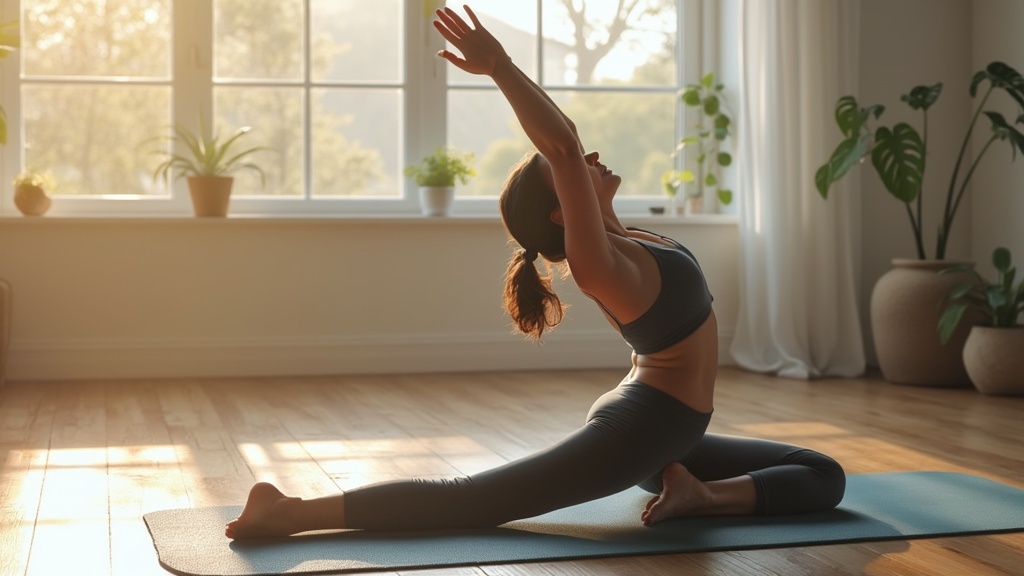
Flexibility significantly impacts daily functioning, creating a ripple effect on overall well-being. Improved flexibility and range of motion lead to better movement efficiency, making everyday tasks easier and more comfortable.
When your body can move freely, activities such as bending, reaching, or even standing become less strenuous.
Increased flexibility plays a significant role in injury prevention, reducing the risk of strains or sprains during physical activities.
Embracing flexibility training fosters a greater sense of physical empowerment, promoting a healthier lifestyle equipped for daily challenges.
Flexibility Training Benefits
The benefits of flexibility training extend well beyond physical fitness goals. Enhanced joint mobility achieved through regular stretching techniques significantly improves overall physical health.
For instance, flexibility training can help athletes experience better sports performance, as increased range of motion allows for improved execution of specific movements.
Daily Activities Impact
After incorporating flexibility training into my routine, I noticed a marked ease in performing daily tasks.
Flexibility exercises not only improved my ability to bend down and tie my shoes without discomfort but also enhanced my overall functional movement.
Regular stretching routines create a foundation for:.
- Injury prevention: Reducing the risk of strains and sprains during physical activities.
- Muscle elasticity: Supporting joint health and improving posture.
- Mobility drills: Enhancing core stability and promoting better body alignment.
Long-term Health Benefits
Engaging in flexibility training regularly contributes to various long-term health benefits. These include:.
- Enhanced recovery techniques: Reducing muscle tension and aiding muscle recovery.
- Improved movement efficiency: Leading to better athletic performance.
- Better relaxation techniques: Assisting with stress reduction through enhanced body awareness.
Ultimately, flexibility training serves as an essential component of a well-rounded fitness routine. By setting specific flexibility goals, individuals can experience a notable enhancement in their daily lives.

How To Incorporate Stretching Techniques
Integrating effective stretching techniques into your routine significantly enhances flexibility and boosts athletic performance. Dynamic stretching, examples of which include leg swings and arm circles, serves a critical role before workouts.
These movements actively warm up the muscles, preparing them for physical exertion.
In contrast, static stretching, such as hamstring and quadriceps stretches, should be performed post-workout to improve muscle elasticity.
To efficiently incorporate stretching into a busy schedule, individuals may set aside just five minutes during breaks or before bed. This small commitment not only promotes joint mobility but also facilitates relaxation, assisting in achieving your flexibility goals and enhancing overall physical health.
Essential Range Of Motion Exercises
Implementing range of motion exercises is important for maintaining joint health and preventing injuries.
Effective movements can be performed easily at home or in the gym, ensuring accessibility for all fitness levels. Some beneficial range of motion exercises include:.
- Hip Circles: These enhance flexibility in the hip joint.
- Shoulder Rolls: Designed to improve shoulder mobility.
- Lunges with Rotation: Engages the core while stretching the hips.
Tracking progress in flexibility is essential for ongoing motivation and improvement.
To monitor your progress effectively, maintain a weekly log of your flexibility assessments. This log should highlight improvements in joint angles over time. Such a practice not only motivates individuals but also identifies areas needing additional focus, ensuring a comprehensive approach to your fitness routine.
- Dynamic stretching can improve performance by increasing blood flow and muscle temperature.
- Static stretching post-exercise helps reduce muscle soreness and improve recovery.
- Regular range of motion exercises can decrease the risk of injuries by enhancing joint stability.
- Tracking flexibility progress can lead to better adherence to fitness routines and improved results.
Injury Prevention Through Flexibility
Implementing effective flexibility training serves as a key strategy for reducing injury risks in athletes and fitness enthusiasts. Common injuries, including hamstring strains, lower back pain, and shoulder issues, often arise from inadequate flexibility.
Emphasizing warmups and cooldowns in a fitness routine helps enhance joint mobility and promotes muscle elasticity, which together form a solid foundation for injury prevention.
- Incorporate daily stretching exercises into your schedule to improve overall flexibility.
- Engage in physical therapy sessions if you notice persistent tightness or discomfort.
Utilizing these strategies will enhance body alignment and support effective recovery techniques, leading to long-term health benefits.
Effective Warmup Exercises For Mobility
Prioritizing dynamic warmup exercises enhances mobility, effectively preparing the body for physical activity. Key movements such as leg swings and arm circles not only activate major muscle groups but also encourage optimal joint health. Consider incorporating this adaptable routine, suitable for various sports, to maximize performance and minimize injury risk.
- Begin with a series of dynamic stretching exercises to adequately warm up.
- Follow with mobility drills such as hip circles and ankle rolls.
Incorporating these exercises can significantly elevate athletic performance, ensuring your body is thoroughly prepared for the physical demands of your chosen activities.
Injury Prevention Through Flexibility
- Studies show that regular flexibility training can reduce the incidence of injuries by up to 50% in athletes.
- Inadequate flexibility is a leading cause of common injuries, with hamstring strains accounting for 37% of all muscle injuries in sports.
- Dynamic warmups have been found to improve performance metrics, such as speed and agility, by preparing the body for strenuous activity.
- Engaging in a consistent stretching routine can enhance muscle elasticity, which is crucial for maintaining joint health and overall mobility.
Yoga For Flexibility And Posture Improvement
Integrating yoga into your fitness regimen can profoundly impact flexibility and posture. Yoga offers various poses tailored to enhance body alignment and joint health.
For instance, practicing the Downward-Facing Dog significantly stretches multiple muscle groups, particularly the hamstrings and calves.
Meanwhile, the Triangle Pose promotes lateral flexibility, strengthening the legs while improving body alignment.
Essential Yoga Poses for Flexibility
Focusing on specific yoga poses can yield substantial benefits for flexibility training and injury prevention.
Below are key poses that target these areas:.
- Cat-Cow Stretch: This dynamic warmup exercise enhances spinal flexibility and core stability.
- Seated Forward Bend: This static stretching technique effectively lengthens the spine and hamstrings.
- Pigeon Pose: Ideal for hip openers, this pose dramatically improves mobility and alleviates muscle tension.
Incorporating Yoga into Your Routine
Beginners can seamlessly integrate yoga into their fitness routine by implementing a few strategic tips. Start with short sessions, gradually increasing both duration and complexity. Focus on form to maximize benefits while minimizing injury risk. Incorporating relaxation techniques can enhance recovery and improve overall health.
Consistency in practice aids in improving muscle elasticity and supports long-term posture improvement. As flexibility goals progress, practitioners can explore more advanced poses and flexibility programs, further optimizing athletic performance and mobility.
| Yoga Pose | Benefits |
|---|---|
| Downward-Facing Dog | Stretches hamstrings and calves, enhances overall flexibility. |
| Triangle Pose | Improves lateral flexibility and body alignment. |
| Cat-Cow Stretch | Enhances spinal flexibility and core stability. |
| Seated Forward Bend | Lengthens the spine and hamstrings effectively. |
